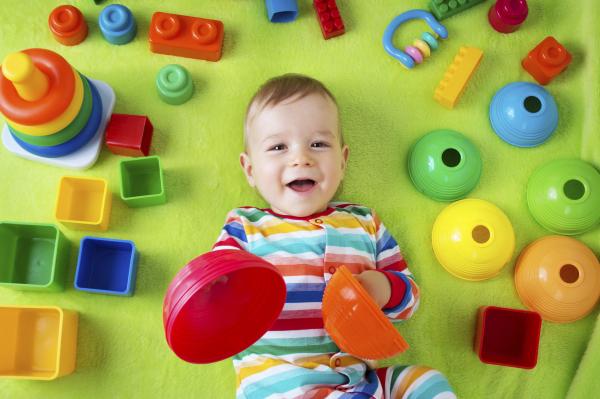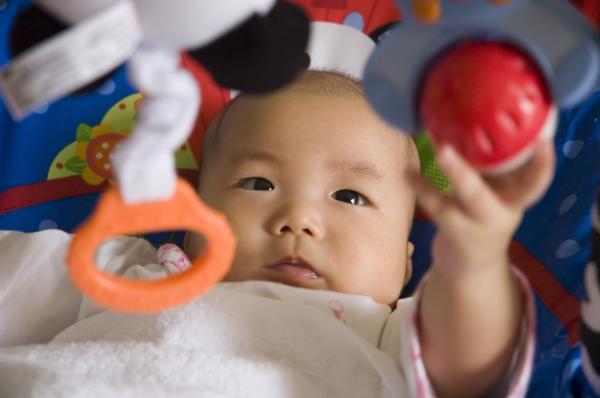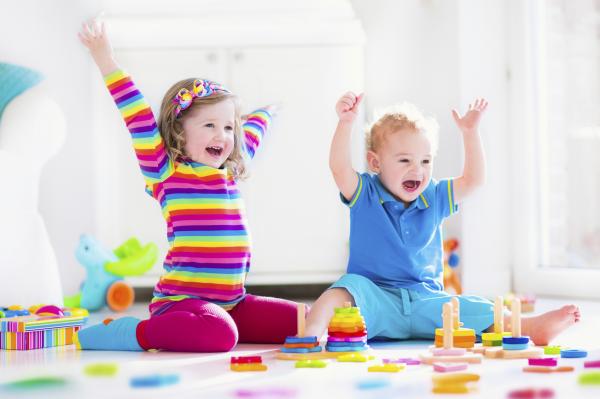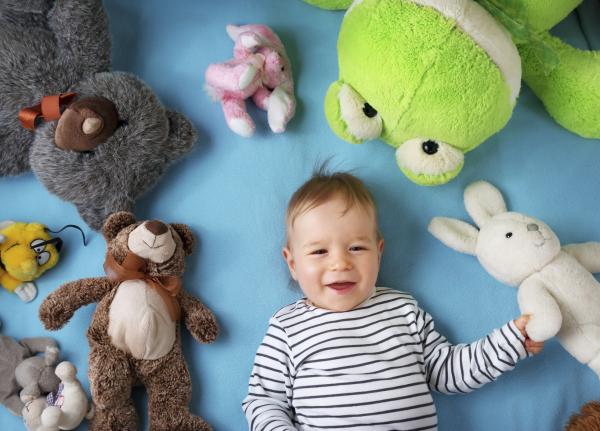
If we really think about all the skills we as human beings need to learn from birth to adulthood, the undertaking seems almost impossible as what we need for both healthy development and self-protection is so vast. Fortunately, we are intuitive animals who learn in our early years by picking up information from how we interact with our environment. For parents, making this environment productive and stimulating is a never-ending task. If we want to give our little ones the best start in life we will want to consider all the elements of how our child will grow. Toys help kids with everything from intellectual development to social progression, so keep reading oneHOWTO to learn how to educate children with toys.
Age Appropriate Educational Toys
Our first consideration in how we educate children with toys should be the age of the child. If you've ever picked up a baby you will know the necessity of supporting their head and neck. This is because not only are they often too weak to keep their head up on their own, but because they don't know some of the basic laws of physics such as gravity or transfer of energy. Older children will have learned these rules, so what they need from a toy will change.
- For babies: you will need educational toys which will stimulate getting to know the lay of the land, so rattles and mobiles are great toys to educate children with. You need educational toys which help baby to differentiate between colors, see how movement works and listen out for sounds.
- For toddlers: blocks should be used as soon as possible, but they are particularly useful for toddlers as they help develop logic, space and basic motor skills. They will also be starting to use their legs more so will want to climb on things and play with others. Wagons and push toys start to become more important.
- For pre-school and up: for some, school and play are two incompatible things, but really they go hand in hand. Children at this age will need to start thinking of numbers and letters, so find educational toys which incorporate these into their play. Educate children with toys which play sounds and books with strong visualization at this time. Using puppets also has a great bonus for parents in the form of bonding as they associate your presence with happy times.

Types of Educational Toy
There are four main types of toys as they promote particular types of development. These are:
- Physical toys: these include wagons, trikes and climbable toys. They help strengthen the muscles we use on an everyday basis and also help us learn techniques important to later life such as how digging in a sand box will help us adapt to the use of tools. Although physical educational toys are good, they may be too young to ride a bike.
- Sensory toys: these are the educational toys which help us to develop our main senses of touch, taste, smell, sight and sound. Playing with bubbles, toys with flashing lights and musical instruments are great ways of helping to improve sense perception. Play-Doh is particularly good as it helps encourage touch, sight, smell and taste without being damaging to the kids (it is non-toxic if consumed).
- Social toys: this is how we interact with others, so games which you can share, such as kicking a ball, and ones which use the imagination are great. This latter category includes dress-up, dolls and toy cars which helps stimulate children into thinking about how they interact with the wider world around them.
- Intellectual toys: these educational toys help to stimulate the creative side of a child's brain by using paints, clay and books to find a means of communication and use their intellect to solve intellectual problems. For example, an educational toy like a book requires a greater intellectual ability than a rattle.

Educate Children with Personalized Learning
Even though it is still in a developmental stage, children have personalities just like anyone else. Working with these personalities rather than against them is going to be best for a healthy adolescence later on as they learn not only intellectual ability, but also self-worth. This means that even though you may love music and want your child to follow in your footsteps, forcing a child with little interest or aptitude to learn your favorite instrument might not be helpful. Find out what they like and educate around that. If they were meant to be a great talent at something in particular it will most often be because they were nurtured in it the right way. Whatever way this will be is up to the individual child and there will be appropriate educational toys for them.
Also, don't rely on outmoded boundaries which might not be helpful for the child's growth. Gender differences in educational toys (all toys) are not as important as some think, especially in the early years. Studies have shown that some toys which are commonly thought of as male centric, such as construction toys and vehicles, actually have a better quality of play when used by girls. Help them to explore everything openly and safely and they will find their niche eventually.
Many children will find educational toys which they want to hold on to more than others, particularly stuffed toys and teddy bears. These can be great tools as they help a child to create their own means of support and develop character. They can also be used to teach lessons and make mundane tasks more acceptable. The character they impart on their furry friend will also help you to know more about your child.

Educate Children Safely
This seems to be a no-brainer, but can sometimes be more difficult a consideration that you might think. It is the reason why almost all educational toys will have an age guide on them, e.g. ages 3 and up. Playing with bubbles will be great for a toddler's sensory development, but mistaking a bottle of soap solution for a sudsy sippy cup will not do them much good. You will have to keep certain toys out of the way and only let them play when supervised.
Children might get bolder as they grow, but sometimes bad experiences can stunt their development as they associate relatively safe things with these experiences. Use educational toys to help them overcome stumbling blocks in any of the four main types of development which toys can improve. An example might be if they fall off a trike and don't want to get back on, you will tactfully want to reintroduce this toy back into play at a later stage.
If you want to incorporate TV into a child's learning development (which can be very useful if used responsibly), make sure to audit their programs first to ensure that what they are consuming is appropriate. Educate yourself as you educate children with toys.

Trial and Error
It is difficult to say what toys will be better for a child's educational development as it is such a personal matter. Follow your instincts as a parent and pay attention to the little habits they form as they advance their play activities. It is also helpful to ask other parents what they might be doing in the same area with their kids. If a toy is being used inappropriately, take it away until they can use it in a more healthy way or replace it with something better suited to their character and level of growth.
When they get to the stage where they can express opinions on their preferences, ask them about it and make sure they want to play with them for the right reasons (not just because so-and-so down the road has one). Learning what types of toys will work best for your child will be as much about what they learn as what you do, so be receptive and have their best interests at heart.

If you want to read similar articles to How to Educate Children with Toys, we recommend you visit our Being a Mom & Dad category.